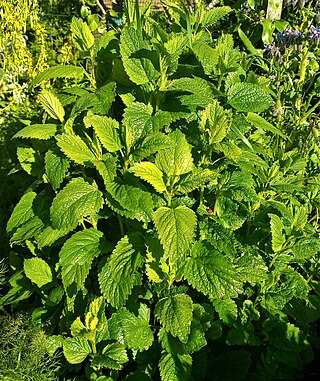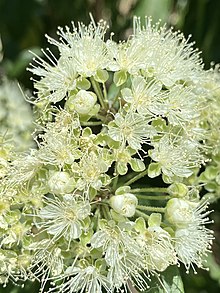
The bay leaf is an aromatic leaf commonly used as a herb in cooking. It can be used whole, either dried or fresh, in which case it is removed from the dish before consumption, or less commonly used in ground form. The flavor that a bay leaf imparts to a dish has not been universally agreed upon, but many agree it is a subtle addition.

Lemon balm is a perennial herbaceous plant in the mint family and native to south-central Europe, the Mediterranean Basin, Iran, and Central Asia, but now naturalised elsewhere.

Basil, also called great basil, is a culinary herb of the family Lamiaceae (mints). It is a tender plant, and is used in cuisines worldwide. In Western cuisine, the generic term "basil" refers to the variety also known as Genovese basil or sweet basil. Basil is native to tropical regions from Central Africa to Southeast Asia. In temperate climates basil is treated as an annual plant, but it can be grown as a short-lived perennial or biennial in warmer horticultural zones with tropical or Mediterranean climates.

Aloysia citrodora, lemon verbena, is a species of flowering plant in the verbena family Verbenaceae, native to South America. Other common names include lemon beebrush. It was brought to Europe by the Spanish and the Portuguese in the 17th century and cultivated for its oil.

Citral is an acyclic monoterpene aldehyde. Being a monoterpene, it is made of two isoprene units. Citral is a collective term which covers two geometric isomers that have their own separate names; the E-isomer is named geranial or citral A. The Z-isomer is named neral or citral B. These stereoisomers occur as a mixture, often not in equal proportions; e.g. in essential oil of Australian ginger, the neral to geranial ratio is 0.61.

Backhousia is a genus of thirteen currently known species of flowering plants in the family Myrtaceae. All the currently known species are endemic to Australia in the rainforests and seasonally dry forests of Queensland, New South Wales and Western Australia.

Myrcene, or β-myrcene, is a monoterpene. A colorless oil, it occurs widely in essential oils. It is produced mainly semi-synthetically from Myrcia, from which it gets its name. It is an intermediate in the production of several fragrances. An less-common isomeric form, having one of the three alkene units in a different position, is α-myrcene.

Eucalyptus oil is the generic name for distilled oil from the leaves of Eucalyptus, a genus of the plant family Myrtaceae, mostly native to Australia but cultivated worldwide. Eucalyptus oil has a history of wide application, as a pharmaceutical, antiseptic, repellent, flavouring and fragrance, as well as having industrial uses. The leaves of selected Eucalyptus species are steam distilled to extract eucalyptus oil.

Corymbia citriodora, commonly known as lemon-scented gum and other common names, is a species of tall tree that is endemic to north-eastern Australia. It has smooth white to pink bark, narrow lance-shaped to curved adult leaves, flower buds in groups of three, white flowers and urn-shaped or barrel-shaped fruit.

Syzygium anisatum, with common names ringwood and aniseed tree, is a rare Australian rainforest tree with an aromatic leaf that has an essential oil profile comparable to true aniseed.

Backhousia myrtifolia is a small rainforest tree species which grows in subtropical rainforests of Eastern Australia. First discovered and subsequently used by the indigenous communities of Australia, this plant produces oils that have a cinnamon-like aroma, and display both anti-bacterial and anti-fungal properties. Therefore, it has potential applications as not only a spice in food preparation, but also in the medical field as a treatment option for microbial infection. Backhousia myrtifolia can grow up to 30 metres. The leaves are ovate or elliptic, 4–7 cm long, and the flowers star-shaped in appearance.
The modern Australian native food industry, also called the bushfood industry, had its initial beginnings in the 1970s and early 1980s, when regional enthusiasts and researchers started to target local native species for use as food. Indigenous Australians had been harvesting many species for use as food and medicines for millennia. In the mid 1970s Brian Powell recognised the commercial potential of quangdong fruit and began its cultivation in orchards. Following this, the CSIRO became involved in quangdong research.
Peter Hardwick is an Australian food horticulturist and environmentalist, recognized as an early pioneer of the Australian bushfood industry. He publicly challenged the established belief that native Australian food plants were not suitable for cropping; conceived the commercial strategy of processing strong flavored native food plants; and, developed the use of wild and seedling genetic diversity to overcome the lack of domesticated varieties previously considered a limitation with Australian native food plants.

Darwinia citriodora, commonly known as lemon-scented darwinia or lemon scented myrtle, is a plant in the myrtle family Myrtaceae and is endemic to the south-west of Western Australia. It is a shrub with oblong to lance-shaped leaves and red, yellow and orange flowers over an extended period. It is a hardy plant in well-drained soil, is often cultivated and used as a rootstock for less hardy species.

Austromyrtus dulcis is a species of plant native to eastern Australia. It grows as a small spreading shrub and is easily recognised by its characteristic berries that usually ripen in summer and autumn. Common names include the midgen berry, midyim, and silky myrtle.

Backhousia subargentea is a rare Australian rainforest tree, growing near Mullumbimby in northeastern New South Wales and from Boonah to Imbil in southeastern Queensland.
Melaleuca stipitata is a plant in the myrtle family, Myrtaceae and is endemic to a small area in the Northern Territory of Australia. It is a rare species, only discovered in 1991 and is unusual in that it is the only known example of Melaleuca having stalked flowers. Its leaves have an essential oil with a pleasant, lemon scent possibly suitable for commercial production.
Manuka oil is an essential oil obtained from the steam distillation of the leaves and small branches of the tree Leptospermum scoparium . Though it is used in a wide range of cosmetics, cosmeceuticals and naturopathic and topical medications, manuka oil is a relatively new development; it was first identified during the 1970s and has been produced commercially since the 1980s and investigated by global research teams since then.

















